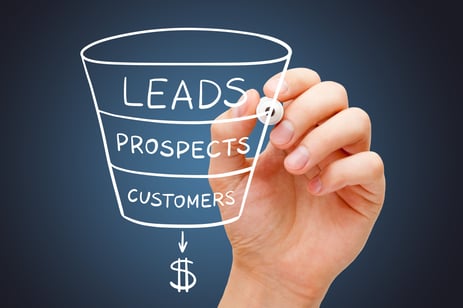Inbound Marketing Blog
for Manufacturers and Healthcare Companies
What Does It Mean to Qualify a B2B Lead? (& How to Do It)
You have leads coming to your website. Some won’t ever buy. Some are browsing. Some are considering.
How do you know which leads to nurture and how to nurture them in customers?
You need a consistent, teamwide process for qualifying leads. What does it mean to qualify a lead? It’s the process of determining if a lead is worth investing in or should be deleted from your contacts.
Qualifying leads helps you share the right information with the right people at the right time.
What Does Lead Qualification Mean, & Why’s It Important?
Lead qualification enables you to prioritize your marketing and sales efforts.

Let’s say a visitor comes to your site that you determine to be a B2B marketing qualified lead (MQL).
Which marketing tactics will nurture this lead into a sales qualified lead (SQL)? When a lead is determined to be sales qualified, what activities are set in motion to nurture them into becoming a customer?
Qualifying also allows you to see beyond a sea of contacts. You can stare at 1,000 leads and just see a bunch of names -- Dale Smith,
Gene Warren, etc. By qualifying leads you start seeing Dale Smith -- qualified lead; or Gene Warren -- disqualified lead, delete from contacts.
Consistent Lead Qualification Definitions Are Important
Whether the conversation happens between in-house sales and marketing teams or between a sales team and an outside agency, everyone needs to define lead stages the same way. This helps everyone qualify and tend to leads in the same way.
Generally speaking, an MQL is a prospect who is a good fit for your company but may not be ready to make a purchase. You want to give this lead educational material that addresses their pain points.
An SQL is someone who’s interested in solving their problem and considering who they want to solve it. They’re ready or almost ready to talk to a sales team, or maybe even request a quote. A sales conversation should be happening by now.
Marketing and sales teams should have consistent answers to questions like:
- Are qualified leads most often coming from a certain industry?
- Are they usually a company of a certain size?
- Do they tend to offer the same/similar products or services?
Lead qualification is helpful when developing a strategy for both before and after someone becomes a lead. Knowing what sales considers to be a qualified lead helps marketers adjust their targeting. They can filter qualified leads from unqualified leads at the MQL stage and save the sales time from wasting time on bad-fit leads.
Don’t Make These Lead Qualification Mistakes
You don’t want to disqualify leads too soon. You also don’t want to scare them away. Two mistakes often made when qualifying leads include:
- Getting rid of the “tire kickers”
- Sicking sales on a lead prematurely
Getting Rid of the ‘Tire Kickers’
You probably have leads that poked around a few pages and filled out a form to download a whitepaper or e-book -- but blew off every follow-up email you sent. You could automatically dismiss them as a waste of time, but you may miss out on good leads. In particular, B2B sales cycles tend to be several months to years long, so don’t pout because you didn’t close a sale in month 1.
Here’s another common practice that may bite you in the rear: disqualifying leads who converted with a personal email address (rather than “genewarren@companyname.com”). Weeding out the “@gmails” of the world can work for big corporations with high lead volumes. But this doesn’t necessarily work for smaller companies that need all the leads they can get. These companies may need to manually qualify their leads because they may find genewarren@hotmail.com does a lot of job-related research off the clock (and therefore used his personal email).
Sicking Sales on a Lead Before They’re Ready
A lead becoming sales qualified doesn’t necessarily mean they’re ready to talk with a salesperson. They may still need some nurturing or education.
Entering into a sales conversation with them too soon may scare them off. This is doubly true if you use a pushy or “me-focused” approach rather than an inbound sales mindset.
Lead Qualification Reporting
Ideally, you're working with a customer relationship management tool (CRM) that logs and tracks all of your marketing data. Closed-loop reporting allows you to see all touchpoints each lead has through your site.
of your marketing data. Closed-loop reporting allows you to see all touchpoints each lead has through your site.
In a perfect world, a marketer measures everything from the gross number of conversions to new contacts, new contacts by source, and the new contacts by quality.
For example, let’s say you generated 180 leads. Of those, 60 were SQLs. Those leads should be examined to see:
- What page visits they have in common
- What page they first entered from
- Where they went from there
- What they downloaded.
Having a CRM lead qualification process information helps marketers better understand the content that generates leads. It takes some of the guesswork out of content creation when you base your strategy on what’s already worked.
Where’s the Best Place to Start When Qualifying Leads?
Research the lead. Start with your CRM.
Did a lead fill out a form? If that information is stored in a CRM, you now have high-level information about them that can help qualify the lead, like:
- Is their business a good fit for your products or services?
- Where in the decision-making stage are they?
- Do they fit a trend in location, industry, or another trait?
You can also peek at the lead’s LinkedIn profile or their company’s website to get a feel for who this lead is. Store any relevant information in your CRM.
You can only make initial assumptions until you have a conversation, but you could use something like lead scoring to compile a score for that person to determine at what stage in the buyer’s journey they’re in.
Marketing Assets Can Help Sales to Qualify Leads

Marketers should produce content for each stage of the buyer’s journey.
That can help sales see where a lead is in their journey. Seeing leads consume decision-stage resources gives a pretty good indication that they are sales-qualified leads, especially if they stay on that page for several minutes or visit it multiple times.
For example, did they look at the pricing page? They may be nearing a decision. Did they look at the Our Team page? They may be curious about who they may be working with.
Don’t Get Antsy
The ideal buyer’s journey is linear. In reality, it doesn’t always work out like that.
Let’s say you have someone in your CRM who’s listed as an MQL. But you want to really work with them, so you list them as an SQL, even though you’ve seen no activity to indicate this lead is one. The sales team jumps in and quickly scares the prospect off.
As an alternative to this sad scenario, develop a campaign that could target that lead and others like them. Send them marketing resources based on pages they’ve viewed. Personalize your communication with them. Don’t send them to sales yet -- stick to being helpful and educational.
Lead Generation Takes Time & Skill
Your website should be a 24/7 funnel-filling machine. Download our guide to B2B lead generation:
Looking For a Deeper Dive?
For a deeper dive into the topic, watch the video version of this article above. Josh Curcio, COO and partner at protocol 80 (and self-proclaimed HubSpot expert), and Holly McCully, inbound marketing consultant at p80 (and niche inbound strategy expert), share how to qualify B2B leads.
Our Blogs, Direct to Your Inbox!
How to Audit your Online Marketing
If you are executing digital marketing, congratulations! You are most likely already one step ahead of your competition, and making strides to meaningfully connect with prospects online. But, how do you know if you’re seeing continual success year over year, and improving your metrics?
Without the tools in place to analyze and benchmark your efforts, it is impossible to scale your online marketing and ensure continuous success.

